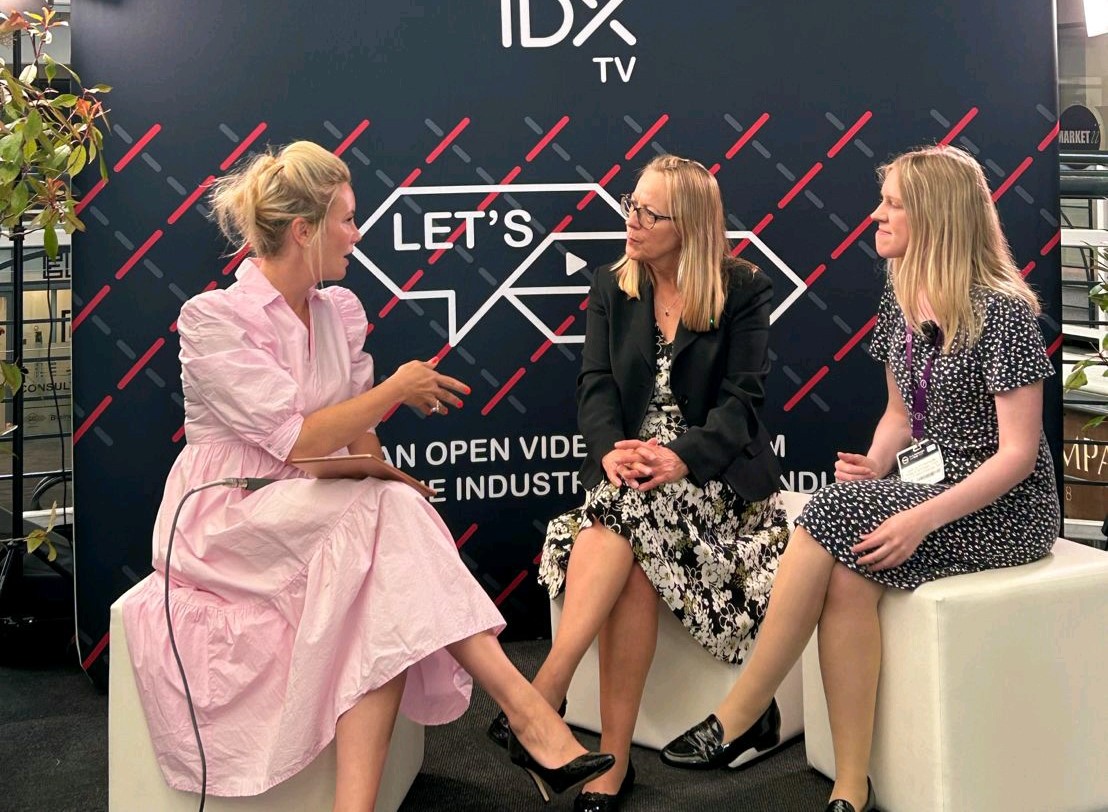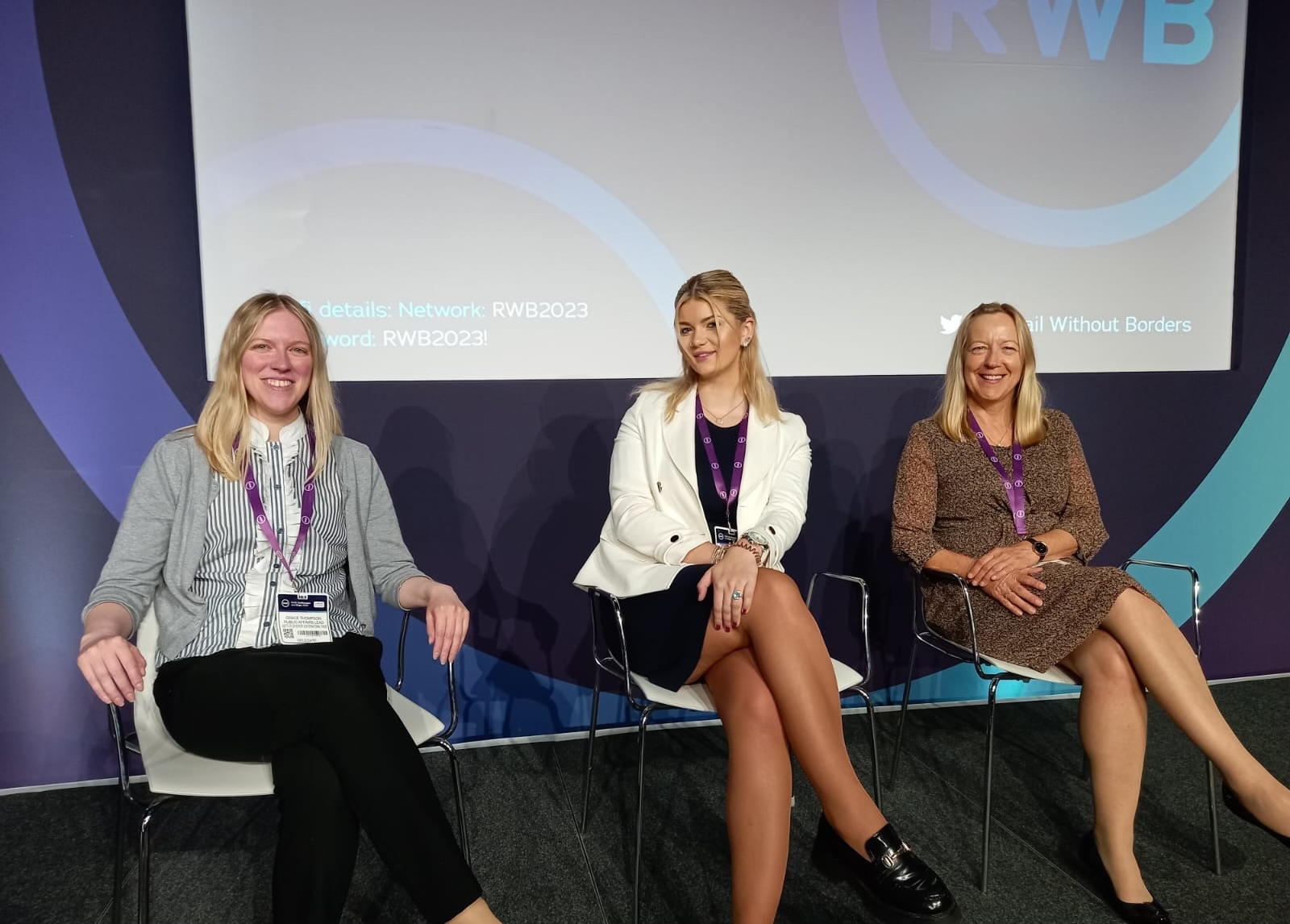
[Image: Susan Roe, E-Commerce Trade Commission secretariat lead, center, and Grace Thompson, IOE&IT public affairs lead, right, speak to IDX TV]
The Retail Without Borders 2023 (RWB) conference took place this week, at the Business Design Centre in Islington, London (11-12 July).
Industry experts held panel sessions on topics connected to e-commerce and online marketplaces, with the Institute of Export & International Trade (IOE&IT) sending a delegation to attend.
Susan Roe, IOE&IT trade & customs specialist and secretariat lead at the recently convened E-Commerce Trade Commission, took part in a panel discussion to highlight the opportunities of selling into the EU.
Trade commission
Roe was joined by Grace Thompson, IOE&IT public affairs lead, and Roxana Borta, IOE&IT intern, at the conference, to gather information from industry for the Commission, as well as to promote its work in helping more businesses start their e-commerce exporting journey.
Thompson said:
“What was most clear to me from the conference was the number of different strategies and tools that are available to help businesses who want to start their journey trading on online marketplaces.
“We are excited to be looking at these types of support, particularly for small businesses, as part of our work on the E-Commerce Trade Commission.”
So, what were the five main takeaways from the conference?
1. Artificial Intelligence
AI has emerged as a hot topic everywhere since the release of the more public-facing version of OpenAI’s large language model, ChatGPT, towards the end of last year.
While there appears to be some resistance to using AI at the front end of business processes - especially in customer service, where customers are still demanding a more personalised and human approach - several businesses are using it successfully in other e-commerce processes.
These include order management, attribute mapping and multiple language translation. It is even starting to be used for completing customs procedures.

[Image: Susan Roe on a panel discussion]
The discussions at the event were “great to hear”, according to Roe, who said that the overall tone of the talks reassured her about the development, and possible future success, of the technology:
“This leverage will undoubtedly instil confidence for the smaller businesses who are yet to take their first steps into using AI as a cost- and resource-effective solution to start and grow cross-border sales.”
2. Localisation and personalisation
Various industry veterans consistently highlighted the need for businesses to think about how to localise and personalise their brands and products.
The key bit of advice for delegates was to keep potential buyers engaged online. In particular, the user experience needs to be more engaging than ever on a personal level. Several speakers mentioned that their companies had been investing heavily in this in recent years.
Harnessing the power of AI and other emerging technologies to enhance a website’s personal touch is something that more businesses expect to be exploring in the coming years.
3. B2B e-commerce
Another positive development in the e-commerce tech space was focused on the complexities of B2B transactional websites.
Due to the disparity of pricing structures and other differences with a B2B sales model, and the fact that B2B decision makers are wanting the same frictionless experience on a B2B website as they would a B2C website, this is welcome news for many.
It addresses the issues of businesses having to either continue with a complex and costly mix of digital and manual processes for transactions or finding additional investment to fund completely rebuilding their website.
4. China’s Dynamic Marketplace
The conference featured a thought-provoking discussion on the complex and intricate nature of China’s marketplace and the challenges faced by brands working there.
With Tmall, Taobao and JD.com dominating the fast-paced Chinese e-commerce scene, there are distinctive features and common pitfalls for global brands venturing here.
To avoid falling foul of these, the key tip was to identify the significance of trade partnerships, comprehend the various consumer segments and explore forthcoming e-commerce innovations originating from China.
5. Sustainability vs. Convenience
One of the major attractions of online marketplaces for consumers is the convenience they can provide, both in terms of personalisation of shopping and delivery.
However, one of the most interesting points to emerge from RWB was the tension between this convenience and the need for the industry to become more sustainable and make supply chains shorter, cleaner and greener.
Håkan Thyr, chief revenue officer at Fruugo, drew out this tension particularly well and wondered whether the sustainability agenda would ever progress to a point where consumers de-prioritised the need for convenience.
The E-Commerce Trade Commission, convened by IOE&IT, aims to support small businesses to either start or grow their exports. For more details on other members and its remit, click here.




